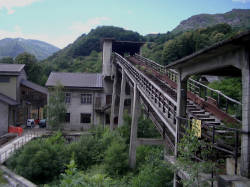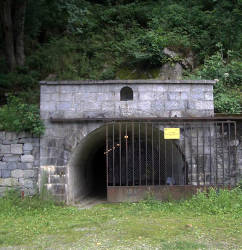Museo delle miniere di Traversella
Useful Information
| Location: |
Località Miniere, 10080 Traversella (TO).
Motorway Turino-Aosta exit Ivrea, follow brown signs "Valchiusella". (45.513833, 7.757507) |
| Open: |
MAY to SEP Sat, Sun 14:30-17:30. [2022] |
| Fee: |
Adults EUR 3, Children (5-12) EUR 1.50. [2022] |
| Classification: |
 Iron Mine Iron Mine
 Tungsten Mine Tungsten Mine
 Mining Museum Mining Museum
|
| Light: |
 Electric Light Electric Light
|
| Dimension: | |
| Guided tours: | self guided |
| Photography: | allowed |
| Accessibility: | no |
| Bibliography: |
Roberta Oberti, Massimo Boiocchi, Frank C. Hawthorne, Neil A. Ball, Fernando Cámara, Renato Pagano, Adriana Pagano (2016): Ferro-ferri-hornblende from the Traversella mine (Ivrea, Italy): occurrence, mineral description and crystal-chemistry Mineralogical Magazine, 1 December 2016, vol. 80, no. 7, pp. 1233-1242(10). DOI pdf online S. Gallo (1973): The Mines of Traversella Min. Rec., Vol.4, H.1, S.39-41. J. Vander Auwera, J. Verkaeren (1993): Occurrence of contrasting skarn formations in dolomites of the Traversella deposit (Ivrea, It.) Geol. Rundschau, 82: 726-40. GMV Gruppo Mineral. Valchiusella, R. Pagano, A. Barresi (2005): La miniera di Traversella: passato, presente e futuro Riv. Min. Ital., 1/2005, 8-26. Emanuele Costa, Giovanna Antonella Dino, Piera Benna, Piergiorgio Rossetti (2019): The Traversella Mining Site as Piemonte Geosite Geoheritage volume 11, pages 55–70 (2019). DOI pdf online |
| Address: |
Museo delle miniere di Traversella, Via Fornello Ex Chioso, 10080 Traversella TO, Tel: +39-0125-794005.
GMV Gruppo Mineral. Valchiusella, Località Miniere, 10080 Traversella (TO), Tel: +39-34983-80655, Tel: +39-34969-44331, Tel: +39-34743-41756. E-mail: |
| As far as we know this information was accurate when it was published (see years in brackets), but may have changed since then. Please check rates and details directly with the companies in question if you need more recent info. |
|
History
| ~100 BC | mining by the local Celts and Romans first mentioned by Titus Livius. |
| 11th century | mining first documented in the Middle Ages. |
| ~1900 | mines closed due to foreign competition. |
| 1914 | concession of the mines passed to Ferriere Piemontesi, owned by FIAT. |
| 1936 | mines reopened dur to political changes. |
| 1959 | spectacular geode with amethyst found during mining. |
| 1971 | mine closed. |
| 2007 | museum opened by the GMV with the help of the Traversella Municipality. |
Geology
The Bersella valley contains deposits of iron ore, like magnetite and pyrite, tungsten as scheelite, and small amounts of copper. They are combined with silicates like garnets, chlorites, epidote, and pyroxenes. The mine provided an enormous range of interesting minerals and is world-famous. It is a typical skarn deposit at the contact between a dioritic body (Traversella pluton) and preexisting metamorphic host rocks.
The Traversella pluton was both, the source of the metasomatizing fluids and the "thermal engine" of the system. It is exposed in abandoned and active quarries close to Traversella and Vico Canavese villages. It is also visible along the Anglosarda tunnel of the mine. It consists of medium- to fine-grained plutonic rock ranging in composition from quartz-diorite to monzodiorite.
The mineral with the funny name, ferro-ferri-hornblende, has its type locality at the Traversella mine. The holotype specimen is from the historical collection of Leandro De Magistris. The mineral was first named speziaite by Colomba in 1914 in honour of Giorgio Spezia (*1842-✝1911), professor of Mineralogy at the University of Turin. In 1905 he developed a method for the hydrothermal synthesis of quartz, and one reason was probably that he was recently deceased. However, they both had no luck with this choice, as their colleagues discredited speziaite as hornblende. The fact that the type specimen is intergrown with hastingsite and magnesio-hastingsite complicates the situation even more. On the other side, the mineral is a good topic for a publication even after 100 years.
Description


Museo delle miniere di Traversella (Mining Museum of Traversella) is a rather long name, sometimes they use the even longer Museo Mineralogico della Miniera di Traversella. They are quite fond it is part of the ecomuseum, though nobody actually knows what an ecomuseum is, but it has eco in the name. But if you remove the marketing babble, the iron mine of Traversella and the minerals remain. It’s an abandoned iron mine with numerous impressive buildings along the road, the headframe, the engine room, conveyor belts and more. The buildings were renovated to house the mineralogical exhibition. So this is actually not so much a mining museum, it’s mainly a mineral museum dedicated to the exceptional minerals which were found here. Even if you are not a mineralogist, what you see here is awe-inspiring.
According to legend mining started in the area with the Gauls, if you know your Asterix, those are the guys with the horned helmets and the names ending on -ix. But actually on the spur of Balma Bianca, north of Traversella, there are traces of mining workings which were dated to the Salassi, a Celtic tribe which lived in the area from 400 BC. Around 100 BC they became Romans, and Titus Livius writes that the consul Appius Claudius came to terms with the Salassi and occupied their mines, including those of Brosso and Phornellus-Proelim, in Traversella. The iron and copper was extracted to arm the Roman garrisons in Eporedia (Ivrea) and Augusta Praetoria (Aosta). In the Middle Ages mining increased and became an important economic resource for the local community. Mining rights were a matter of dispute with local feudal lords, so we find a lot of documents.
"A stony and barren place where neither grain nor wine is harvested, except for a little chestnuts that are not enough for the fourth part of the year ...
and in which the inhabitants could neither dwell nor live without iron ore ..."
A description of Traversella from 1571.
Over centuries the tunnels were built into the mountainside, without any planning, just following the ore seams. At some point this resulted in unnecessary cave-ins and loss of life. The mining increased in the 19th century as a result of the industrial revolution and the demand of iron. But around 1900 foreign competition made the mines unprofitable and the mines and the processing facilities were shut down. In 1914 the concession of the mines passed to Ferriere Piemontesi, owned by FIAT, but the mines remained closed. A significant revival came in 1936 during the fascist period, when economy was less important than politics. And after World War II the mines stayed open, in the 1960s 30-35 miners were working at Traversella. Not a big operation, but nevertheless productive. But the economic changes of the 70s were the end, in 1971 the mine finally closed. There are still substantial reserves, which was proven by geological examination, but the mining is too expensive to be profitable. But who knows, with the massively rising prices of the last decade this might change again.
The mine was closed since 1971 and started to decay. Finally, it was restored and reopened as a museum and show mine. Today it is part of a bigger project called "ecomuseum" financed by the Regione Piemonte. However, they just used what was already there. The local miners have always collected special specimens they found during their work. Some they kept for themselves, others they sold as a small side income. The minerals from this mine became world-famous and there are numerous publications about them. And there is a very active non-profit association of former miners and volunteers who call themselves Gruppo Mineralogico Valchiusella (GMV, Valchiusella Mineralogical Group). They already opened a small museum with mining tools and machinery, and of course their spectacular mineral collection. But help with the renovation of the mine building and a new home for the collection was much appreciated.
There are numerous pages on the web which mention underground tours. As a matter of fact those are not mentioned on the official pages, so we guess they are either discontinued or never existed. The tunnels were visited by scientists but where off limits for tourists since the mine closed. But a Geoheritage publication from 2019 mentions that underground tours would be a good addition for the museum. We guess Covid-19 stopped any development in this direction, or at least postponed it.
The mine is rather easy to find, when you enter the village on the only road there is a turnoff to the right, which is signposted. Then it’s only a few hundred meters, and you can’t miss the headframe. But there is also a second brown sign (brown are the cultural monuments in Italy) to Palestra di Rocca. Even if it is not the topic of showcaves.com as it is not underground, these are rock engravings from the Stone Age, and they are spectacular. If you are in the area, it’s definitely a must to see them.
Today Traversella in the Valchiusella is a picturesque village, base camp for excursions of alpine tours and busy resort. But it is also a famous mineral location and visited by experts and fans of mineralogy. Unlike other countries it’s not forbidden to pick up a rock in Italy and there are numerous salg heaps. However, there are numerous nature protection laws, and you should definitely refrain form disturbing wildlife or destroying plants while collecting minerals.
- See also
 Search DuckDuckGo for "Museo delle miniere di Traversella"
Search DuckDuckGo for "Museo delle miniere di Traversella" Google Earth Placemark
Google Earth Placemark Traversella - Wikipedia (visited: 28-MAY-2022)
Traversella - Wikipedia (visited: 28-MAY-2022) Gruppo Mineralogico Valchiusella, official website
Gruppo Mineralogico Valchiusella, official website  (visited: 28-MAY-2022)
(visited: 28-MAY-2022) MUSEO MINERALOGICO DELLA MINIERA DI TRAVERSELLA (visited: 28-MAY-2022)
MUSEO MINERALOGICO DELLA MINIERA DI TRAVERSELLA (visited: 28-MAY-2022) The mines of Traversella (TO) (visited: 28-MAY-2022)
The mines of Traversella (TO) (visited: 28-MAY-2022) Traversella Mine - mindat.org (visited: 28-MAY-2022)
Traversella Mine - mindat.org (visited: 28-MAY-2022) Miniera Traversella - mineralienatlas.de
Miniera Traversella - mineralienatlas.de  (visited: 28-MAY-2022)
(visited: 28-MAY-2022)
 Index
Index Topics
Topics Hierarchical
Hierarchical Countries
Countries Maps
Maps